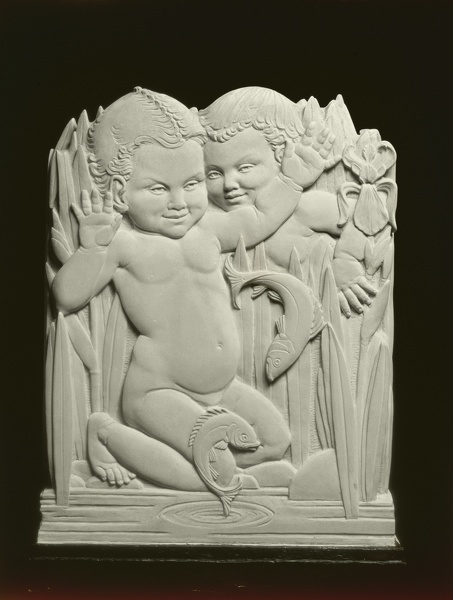

 Hover over the painting to magnify (there may be an initial delay while the magnified image is loaded)
Hover over the painting to magnify (there may be an initial delay while the magnified image is loaded)Joyce Bidder (1906-1999):
The Iris Pool, 1947
None (ref: 9976)
Palomino marble
45.7 x 35.5 x 7.6 cm
See all works by Joyce Bidder sculpture allegory women Fifty Works by Fifty British Women Artists 1900 - 1950
Provenance: Collection of Peyton Skipwith
I first came across Joyce Bidder’s work while assembling a range of sculptures in any media for The Fine Art Society’s 1986 exhibition Sculpture in Britain Between the Wars. I had conceived the idea for this show on New Year’s Day the previous year while arranging a group of white sculptures for a window display on New Bond Street. The group, mainly plasters, included a 1930s stone carving, Eve by Vernon Hill, and to complete the ensemble I needed to find a book with a reproduction of this or a similar piece, so I ransacked our library. By the end of the morning my desk was piled with every relevant book that I could lay my hands on, including the London telephone directories.
Attracted by the window, a man came in and showed me a photograph of a piece of sculpture by Joyce Bidder he wanted to sell. It looked perfect for the exhibition that was already building up in my mind’s eye and I went to see it at his office in Covent Garden. The Roadmakers was a superb relief depicting five muscular men, stripped to the waist, tugging on a rope; it was signed and dated 1935 and was in green Westmorland slate, the figures highly polished, the background dusty with chisel marks showing, and the road surface slightly gilded.
I traced Miss Bidder and her friend Daisy Borne to their studio in Wimbledon, with its accumulation of half a century’s work in stone, terracotta, bronze, plaster, ivory and other materials, and mounted a joint exhibition of their work just before Christmas 1986. On receipt of the catalogue, with The Iris Pool on the cover, Miss Borne told my colleague that they had had “a little weep” – their lifetimes’ work vindicated.
Commentary by Peyton Skipwith, who worked at The Fine Art Society in New Bond Street for forty-four years and is now a freelance fine art consultant, critic and author specialising in British fine and decorative arts 1870-1940.
 Unsung Heroines
Unsung Heroines Private collection
Private collection




